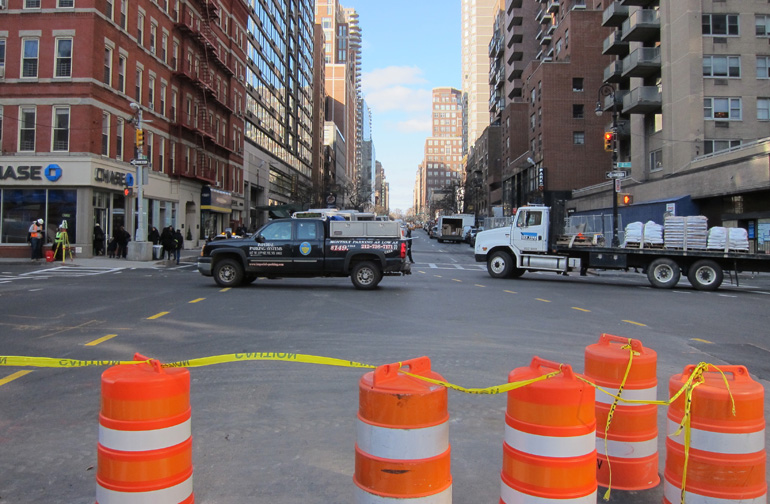Gotham Diary:
Morse Jag
5 January 2012
Thursday, January 5th, 2012
This time, I’m watching the Inspector Morse series in order. I am now. By the time Kathleen rustled up a chronological listing of the episodes, ranging from “The Dead of Jericho” to “Remorseless Day,” I’d watched four episodes. The first one, “Deceived By Flight,” had been easy to choose. I have a thing for Jane Booker’s plummy dry wit (Booker plays an undercover customs agents who’s in pursuit of the cricket-playing drug runners.) Daniel Massey is in the cast — the image of his father, only better-looking. I had completely forgotten his murderer was his wife. That’s the thing about these shows. They’re so packed with layers of story that you can hold on to only a few of the brighter details, like John Normington’s plummet from the spire of St Oswald’s, in “Service For All the Dead.” You may remember who dun it, but, if so, you’ve probably forgotten quite why.
Choosing a second episode to watch was harder. Agony infected the process. Is this the Morse that I really want to watch next? After much shuffling, I selected “Happy Families,” for the simple reason that the title didn’t remind me of anything. The moment the show started, of course, I knew precisely what I was in for: the gruesome decimation of a family fueled by revenge and silly charity in unequal measures. I take it back: sometimes you can remember everything. I even remembered that Kevin Whately would have to dress up like a Wild West sherriff. It was great fun.
By now, in the firm grip of a Morse jag, knowing that I’d have to watch each and every one — in the kitchen, mostly, while emptying the dishwasher or brewing a pot of tea, with the rest of my normal life serving as the spotty commercial breaks — I grasped that it would never do to go on choosing. I kept the CDs in a drawer in alphabetical order, and I think that I watched the shows in that order once, on a long-ago jag — a perhaps unsurprising number of the titles begin with “Dead” or “Death.” I wasn’t going to do that again. I was in the middle of “The Infernal Serpent” (picked because I remembered the studied adagio of Barbara Leigh-Hunt’s impeccable diction) when I resolved to go on-chronology. I remembered “The Dead of Jericho” fairly well, but I’d forgotten that Gemma Jones’s character really does hang herself. And I knew that Morse’s Jaguar would be battered in the interests of justice at both the beginning and the end.
Last night, after dinner, Kathleen and I watched “Service of All the Dead.” I’d finished “The Silent World of Nicholas Quinn” (the second episode) while making dinner — which, in the event, I could hardly eat, because I’d been drinking so much water all day that there was no room in my stomach; among the unappetizing thoughts that crossed my mind at the table was the factoid that you can drown from drinking too much water — and when Kathleen suggested that we watch a Morse, I jumped. Because, as our viewing bore out, “Service” is one of the muddiest of the Morses. Much of it is filmed in a dark old church, full of arrestingly gruesome statuary, lighted by lurid stained glass. The story is unusually tricky, and the storytelling far from straightforward. Kathleen hadn’t seen the episode before at all, and she couldn’t quite believe it when it was over.
One notable thing about “Service of All the Dead” is that it’s the first in the series to have no real University connection. Such episodes are rare, but I’m going to keep track of them as such. (“Happy Families” is another.) In fact, I’m thinking of devising a dataset. “Canals,” for example — do the waterways running through what was, after all, initially a ford figure in the action? That’s a simple yes-or-no. Rating the overt hostility of Morse’s superiors to his “methods” calls for a scale of 1 to 10. The relation of Morse to Detective Sergeant Lewis is more in the nature of a correlation, with .5 representing Lewis’s misgivings and 1 Lewis’s outright doubts.
Although I visited Oxford in 1977, I wasn’t there for very long, and I remember nothing very clearly except stepping into Brasenose, of all places. (I’d be a law student myself a few months later.)  Google Maps has provided inestimable help in placing the scenes that the Inspector Morse series makes so familiar. The labels are hopeless, but that doesn’t matter, because all the series’s colleges are imaginary — Beaumont, Lonsdale, and others. What’s harder to believe, after all these years, is that Morse is imaginary, too.

